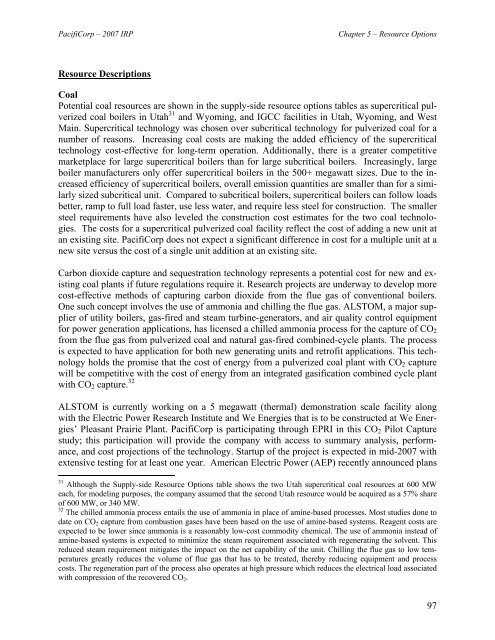PacifiCorp 2007 Integrated Resource Plan (May 30, 2007)
PacifiCorp 2007 Integrated Resource Plan (May 30, 2007)
PacifiCorp 2007 Integrated Resource Plan (May 30, 2007)
You also want an ePaper? Increase the reach of your titles
YUMPU automatically turns print PDFs into web optimized ePapers that Google loves.
<strong>PacifiCorp</strong> – <strong>2007</strong> IRPChapter 5 – <strong>Resource</strong> Options<strong>Resource</strong> DescriptionsCoalPotential coal resources are shown in the supply-side resource options tables as supercritical pulverizedcoal boilers in Utah 31 and Wyoming, and IGCC facilities in Utah, Wyoming, and WestMain. Supercritical technology was chosen over subcritical technology for pulverized coal for anumber of reasons. Increasing coal costs are making the added efficiency of the supercriticaltechnology cost-effective for long-term operation. Additionally, there is a greater competitivemarketplace for large supercritical boilers than for large subcritical boilers. Increasingly, largeboiler manufacturers only offer supercritical boilers in the 500+ megawatt sizes. Due to the increasedefficiency of supercritical boilers, overall emission quantities are smaller than for a similarlysized subcritical unit. Compared to subcritical boilers, supercritical boilers can follow loadsbetter, ramp to full load faster, use less water, and require less steel for construction. The smallersteel requirements have also leveled the construction cost estimates for the two coal technologies.The costs for a supercritical pulverized coal facility reflect the cost of adding a new unit atan existing site. <strong>PacifiCorp</strong> does not expect a significant difference in cost for a multiple unit at anew site versus the cost of a single unit addition at an existing site.Carbon dioxide capture and sequestration technology represents a potential cost for new and existingcoal plants if future regulations require it. Research projects are underway to develop morecost-effective methods of capturing carbon dioxide from the flue gas of conventional boilers.One such concept involves the use of ammonia and chilling the flue gas. ALSTOM, a major supplierof utility boilers, gas-fired and steam turbine-generators, and air quality control equipmentfor power generation applications, has licensed a chilled ammonia process for the capture of CO 2from the flue gas from pulverized coal and natural gas-fired combined-cycle plants. The processis expected to have application for both new generating units and retrofit applications. This technologyholds the promise that the cost of energy from a pulverized coal plant with CO 2 capturewill be competitive with the cost of energy from an integrated gasification combined cycle plantwith CO 2 capture. 32ALSTOM is currently working on a 5 megawatt (thermal) demonstration scale facility alongwith the Electric Power Research Institute and We Energies that is to be constructed at We Energies’Pleasant Prairie <strong>Plan</strong>t. <strong>PacifiCorp</strong> is participating through EPRI in this CO 2 Pilot Capturestudy; this participation will provide the company with access to summary analysis, performance,and cost projections of the technology. Startup of the project is expected in mid-<strong>2007</strong> withextensive testing for at least one year. American Electric Power (AEP) recently announced plans31 Although the Supply-side <strong>Resource</strong> Options table shows the two Utah supercritical coal resources at 600 MWeach, for modeling purposes, the company assumed that the second Utah resource would be acquired as a 57% shareof 600 MW, or 340 MW.32 The chilled ammonia process entails the use of ammonia in place of amine-based processes. Most studies done todate on CO 2 capture from combustion gases have been based on the use of amine-based systems. Reagent costs areexpected to be lower since ammonia is a reasonably low-cost commodity chemical. The use of ammonia instead ofamine-based systems is expected to minimize the steam requirement associated with regenerating the solvent. Thisreduced steam requirement mitigates the impact on the net capability of the unit. Chilling the flue gas to low temperaturesgreatly reduces the volume of flue gas that has to be treated, thereby reducing equipment and processcosts. The regeneration part of the process also operates at high pressure which reduces the electrical load associatedwith compression of the recovered CO 2 .97
















